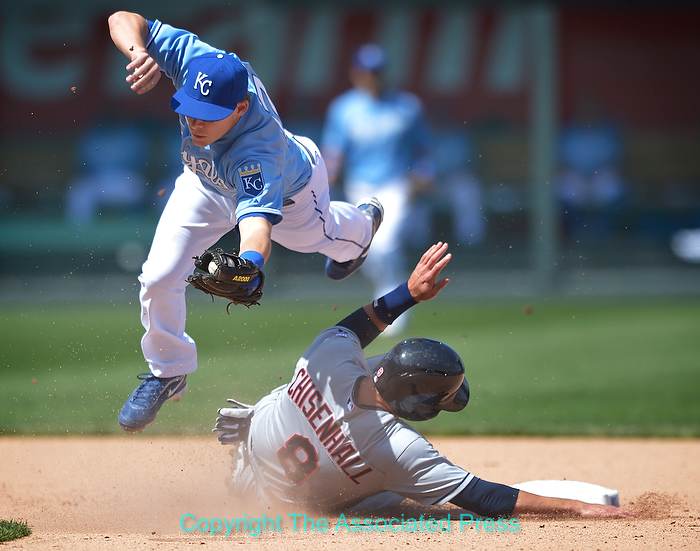I’ve covered professional sports for over thirty years now, and have no hesitation when someone asks me which one’s the hardest. Baseball, hands down. Earlier this week I was assigned to cover three Kansas City Royals games for The Associated Press. Here’s a run-down of what’s involved when doing that, and why it’s such a challenge.
First, you have to get to the park early. Two to three hours before game time. There are many reasons for that. Parking closer means shorter distances to haul all the gear you need. There’s limited space for photographers to work from, so setting up early means you have a spot. You also need to make sure that all the technology you’re using works, from the laptop to the software to the WiFi connection. Oh, and you’ll need to shoot a bunch of photos before the game even starts.
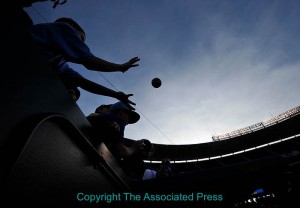
Kids get autographs from players before the start of the game. Photo by Reed Hoffmann, Copyright The Associated Press.
Covering baseball today for the Associated Press means more than just shooting action. You’re expected to produce features from the stadium (fans, mascots, overalls, etc.) as well as shoot players during warm-ups and batting practice. Before the first pitch is thrown, you’ll already have worked about two hours and transmitted 4-5 photos. But that’s the easy, relaxing part. Everything changes once the game starts.
The internet is all about NOW, NOW, NOW! For a photographer that means sometimes transmitting photos within minutes of shooting them. By the end of the first inning, you’re expected to have sent at least 3-4 photos. So in addition to trying to shoot the action, you need to run down into the tunnel
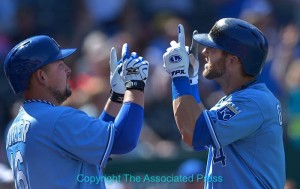
Alex Gordon (right) and Billy Butler celebrate a Gordon home run. Photo by Reed Hoffmann, Copyright The Associated Press.
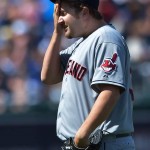
Cleveland’s Matt Albers wipes his face after giving up a second walk. Photo by Reed Hoffmann, Copyright The Associated Press.
(where the work space is), download, prep (fix color if needed, crop, adjust tones), caption and transmit – all while the game continues. And this routine will continue for the next three hours. Shoot, run inside, send photos, run back out, repeat.
Most people think of baseball as a slow game. But there are no team or TV timeouts. The game may not be

Cleveland’s Asdrubal Cabrera lets this pitch go by. Photo by Reed Hoffmann, Copyright The Associated Press.
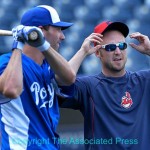
Kansas City’s Jeff Francouer, left, visits with Cleveland’s Ryan Raburn before the game. Photo by Reed Hoffmann, Copyright The Associated Press.

KC’s Lorenzo Cain can’t reach this deep shot by Cleveland’s Jason Kipnis for a home run. Photo by Reed Hoffmann, Copyright The Associated Press.
constant action, but there are few times where you can turn your back on it for more than a couple of minutes confident nothing will happen. It’s a bit stressful.
In the three games I shot over two days, here’s how those days went:
Sunday, April 28: leave home at
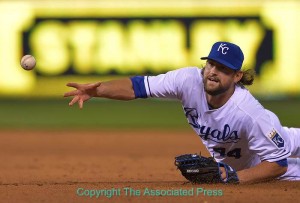
KC’s Luke Hochevar tossed the ball to first but was too late for the out. Photo by Reed Hoffmann, Copyright The Associated Press.
9:30am for a 1:10pm game. Arrive at the stadium and set up computer, check everything’s working, ready at 10:30am. Check the field for any players, none out yet. Take elevator to press box to get rosters, not out yet. Eat a hot dog, drink a soda. Back to the field, shoot players warming up and starting BP (batting practice). Transmit first photos at noon. Get roster from another photographer who went to the press box later. Back to the field, shoot some fans. Transmit. Game starts, transmit starting pitchers. By the end of the game at 4pm, I’ve sent 13 game action and 10 of what are called “outtakes,” both action and feature images that can be used later. Once the game is over I’ll send 11 more outtakes. And during the entire process, I’m in constant contact with the editors in NYC through IM software.
Since Friday night’s game was postponed, they’re playing the second game on Sunday, starting at 7:10pm. That means I’ve got time to charge batteries, format cards, prep new captions and grab a bite to eat before starting to shoot again around 6:15pm (no batting practice since it’s a second game). For the evening game, I’ll send 18 action shots and 19 outtakes. I’m home by 11pm.
Monday, April 29: leave home at 4pm for a 7:10pm game. Pretty much same routine. This time I’ll transmit 22 action photos and 24 outtakes, and be home at 11pm again.
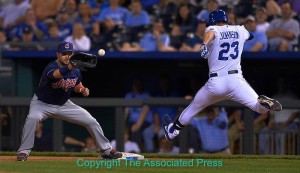
KC’s Elliot Johnson can’t beat the throw to Cleveland’s Nick Swisher at first. Photo by Reed Hoffmann, Copyright The Associated Press.
In the old days of film, we’d normally turn out 4-5 photos from as much of the game as we could stay for. Remember, we had to factor in driving back to the office to process film and make prints. The wire services would often have labs at the pro stadiums to do this, but it still took more time. What we do today is only possible because of digital cameras and computers.
Today’s cameras have amazing autofocus systems, which mean we get more usable pictures (and yes, we still miss a lot). We can shoot good photos at ISO’s unimaginable twenty years ago. Downloading cards to laptops, with Firewire 800 or USB 3 readers, means we can access our photos

Ryan Raburn celebrates his second hime run of the night as he jogs to the Cleveland bench. Photo by Reed Hoffmann, Copyright The Associated Press.
almost instantaneously. Smart use of software like Photo Mechanic, and tools like Code Replacement, makes sorting, captioning and transmitting photos faster than ever before. A good workflow is critical if you’re going to do this successfully.
Despite all these improvements, one thing hasn’t changed. The photographer behind the camera needs to know how to get the best performance out of their gear, have quick reflexes to anticipate action and needs knowledge of the teams and game. I only shoot a few games a season these days, and rarely do as good a job as the regulars I’m sharing the dugout with. But I do have fun when I get out there, both from the camaraderie and the challenge. With any luck, I’ll get a few more opportunities this summer.
Gear used: Nikon D4 and D3 cameras, Nikon 400mm f/2.8 lens (sometimes with TC-14E teleconverter), Nikon 70-200mm f/2.8, Nikon 16-35mm f/4, Apple MacBook Pro with two card readers attached, Photo Mechanic (Camerabits.com) and Photoshop CS4.

